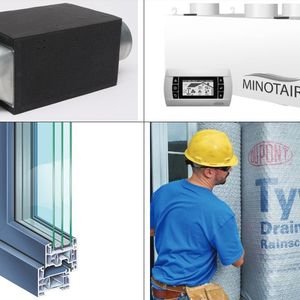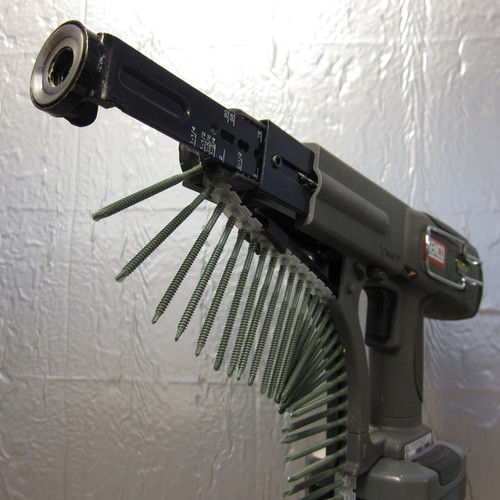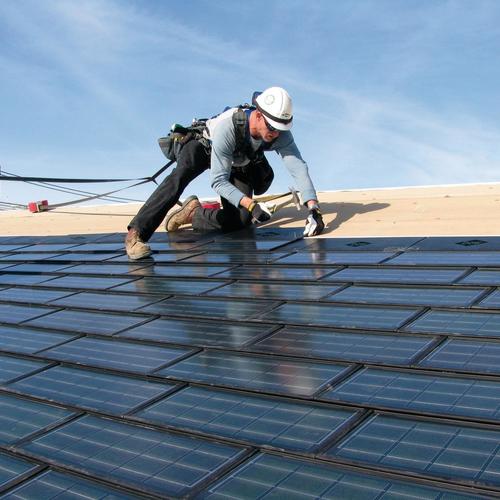
Image Credit: Venmar
It’s been about six months since my last roundup of new green building products. This time I’ll look at two ventilation products (an HRV and a fan), a pressure-balancing grille, and an inexpensive camera to inspect difficult-to-reach areas. I’ll also mention four new North American distributors of European Passivhaus-certified windows.
A very efficient HRV
The first product, the Venmar Eko 1.5 heat-recovery ventilator, isn’t really new — in fact I mentioned it months ago in a previous blog (HRV or ERV?). But when I saw this very efficient HRV at a trade show recently, I decided it was worth highlighting.
The main virtue of the Eko 1.5 is the fact that it uses very little electricity. Powered by two electronically commutated motors (ECMs), it draws only 24 watts at low speed to deliver 49 cfm. According to the Home Ventilating Institute Product Directory, this HRV has a sensible heat-recovery efficiency ranging from 64% at -13°F to 75% at 32°F at 49 cfm.
The Venmar Eko 1.5 is also available with an ERV core. (However, it you’re looking for an efficient ERV rather than an HRV, you’ll probably choose the UltimateAir RecoupAerator 200DX, not the Venmar Eko 1.5).
Delta Products bath exhaust fan rivals the Panasonic
A Taiwanese manufacturer, Delta Products, is challenging Panasonic with its new line of energy-efficient bath exhaust fans.
There are several models of Delta Breez bath fans. The smallest model, Model VFB25AC, draws only 7.1 watts to move 80 cfm, and has a very low sone rating — only 0.3 sone. If the Delta Breez specs are to be believed, this model uses less energy than the Panasonic WhisperGreen FV-08VKS1, which draws 11.3 watts to move 80 cfm.
The Delta Breez VFB25AC is available for $85.80 from Energy Federation Incorporated. For $92.56, EFI also stocks a more powerful model (the Delta Breez VFB25AD)…
Weekly Newsletter
Get building science and energy efficiency advice, plus special offers, in your inbox.

This article is only available to GBA Prime Members
Sign up for a free trial and get instant access to this article as well as GBA’s complete library of premium articles and construction details.
Start Free TrialAlready a member? Log in















22 Comments
'Perfect Balance'
Damn. Why would anyone cut up a perfectly fine door to insert an ugly piece of plastic in the bottom rail when they could do the same thing better with an unobtrusive transfer grill. But they will.
BTW, a traditional stile-and-rail door 30" or less in width will probably be structurally compromised by this butchery. Please god keep it away from the older-home renovation industry.
inspection cameras
Is there a specific reason you chose to highlight the VOScope over some of the other options available? I'm just curious if you compared features and are recommending a specific item, or if you're just highlighting a new technology. These look like great investments for remodeling and diagnostics.
Milwaukee M-Spector $350
http://www.milwaukeetool.com/tools/cordless-tools/m12-cordless-system/m-spector-av-m12-cordless-lithium-ion-multimedia-camera-kit-%2817mm%29/2311-21
Ridgid SeeSnake $225
http://www.ridgid.com/Tools/SeeSnake-micro
DeWalt DCT410S1 $300
http://www.dewalt.com/tools/cordless-instruments-inspection-cameras-dct410s1.aspx
Response to Jason
Jason,
Thanks for providing links to similar products.
I was struck by the fact that the camera I reviewed was affordable, and it came from a distributor I trust (EFI).
I welcome readers sharing their experiences with other similar products.
Breez
I too saw the literature on the Breez fans at the EFI booth at the NESEA conference, and was similarly impressed. They had actual units this weekend at the JLC conference - they are reasonably good-looking (certainly no uglier than Panasonic), and have some nice features, line humidity sensors. I'm planning on using them next time I need a fan.
Agree with James
Cut that vent into a typical door and you have destroyed it structurally. The owner won't know until a few years have passed.
Response to James Morgan and David Meiland
James and David,
After reading your comments, I contacted Tamarack Technologies, and spoke to David Lapollo there. This is what Lapollo told me: "We've tested the product with both hollow-core doors -- the cheap luaun kind -- and with six-panel pine doors, and the product does not cause any problems with the structure of the door. The product is a solid piece of ABS. It's sturdy. And it has a flange that slides up over the door to strengthen the installation. It is attached to the door with screws on the bottom of the door.
"A large home builder, Lennar Homes, has decided to use the product on a big project in Texas. They kicked the tires, so to speak, and decided it works. Lennar Homes has already contacted their door supplier, and the door manufacturer is installing our product in their doors before the doors are being delivered to Lennar Homes. We are very confident about the product, and we will warranty the door if you install it."
ERV power draw
From the manufacturers' performance data it appears the Venmar EKO draws about half the electric power of a RecoupAerator for similar air volume. That is an important advantage for energy efficiency, especially if the unit operates 24/7.
Response to Thomas
Thomas,
That's why I highlighted the Venmar Eko.
However, if I remember correctly, the RecoupAerator unit has a higher heat-recovery efficiency.
Perfect Balance
Very good idea but I agree with James and David in their concerns with retrofit application into a hollow core door. Having worked for one of the major hollow core manufacturers, I'd say field installation will be difficult at best. What Lennar is doing is definitely advisable since they are allowing the manufacturer to design the Perfect Balance into their door system.
Response to Troy
Troy,
I've cut down hollow-core doors before. It's not rocket science; it's wood working. After cutting off the bottom rail, you either relocate it where it belongs (higher up) or cut a new rail on your table saw and slide it in place, secured with glue and clamps.
Response to Martin
You are right on track! I'm not so sure that everyone has your level of understanding of how little structure exists inside a hollow core door. Reinforcement as you have described is going to be very important.
Response to Troy
Troy,
It's a sad day indeed if a residential carpenter doesn't know how to cut down a hollow-core door.
Response to Martin
So only residential carpenters read your blog. Aha, now it's all clear! Never mind...
venmar draw
I was just part of an energy audit that recorded the EKO 1.5 drawing 26 watts at around 40 cfm. this was its lowest setting. Nice unit. You still got the machine noise 24/7 though.
Eko vs. RecoupAerator
So which actually saves more energy, and how much better is it?
Response to Charles Campbell
Charles,
First of all, HRVs and ERVs don't save energy -- they consume energy. Every hour you run an HRV, you use energy. The more it runs, the more energy it uses.
Second, there is no simple question as to which model of HRV or ERV consumes less energy. A high rate of energy recovery (high thermal efficiency) matters a lot if the cost of your heating energy is high, but it doesn't matter much if you the cost of your heating energy is low.
Low electrical use (that is, a low watt draw) matters a lot if your electricity costs are high, but it doesn't matter much if the cost of your electricity is low.
So the answer depends on the relative cost of your heating energy compared to your electricity.
Perfect Balance Door Grill works
I installed Tamarack's grills in the bottom of 5 hollow core interior luan doors in a 1961 Ranch over a year ago. It took 30 to 40 minutes per door to cut the opening and insert, glue and screw a solid block of wood between the hollow panels. The top edge of the device wraps the opening by about 1/2 inch so the screw heads are concealed.
No complaints from tenants and they balance the air better than 1 in. undercuts.
I agree you'd probably choose transfer grills or jump ducts in homes with nice old doors, but for flat slabs or embossed 6 panel doors intended more for function than architectural quality, the Tamarack grills are a viable option and a simple solution.
Correction on Delta Products
Hi Martin,
Thanks for the article. I've got a minor factual correction relating to Delta Products. They are not a small California company. They are a subsidiary of Delta Electronics, Inc., which is a publicly traded company in Taiwan with 74,000 employees and nearly $6 billion in revenues.
I'm glad they are making such high performance fans. Looks like they are leveraging their experience in computer electronics (components such as power supplies and DC motors) to do so.
Response to Matt Jennings
Matt,
Thanks very much for the correction. I've updated the article to reflect the information you provided.
I appreciate your help.
ENERGATE windows
Martin,
Thanks as always for the interesting and informative blog. I always learn something, and make a point to keep up on your posts.
I appreciate the update on the high-performance passive house windows.
I am in the process of purchasing some ENERGATE windows from the H-Window company in Wisc. The specs on the windows are outstanding in all regards, and because the windows are thick 2" triple-pane glass (which typically come filled with Argon gas), they even meet the passive house standard if filled with plain vanilla air and not Argon. I thought that was a benefit over thinner triple-pane windows, since its reassuring to know that they will still perform if the gas leaks out over time. All the other specs, such as VT and SHGC, were also really good.
I hope to receive the windows in a month or so, but so far it has been great working with H Windows, their U.S. rep. They've been very helpful in the many choices one must make to fully specify a window package.
Rob
Home ventilation and indoor air quality
Martin,
I have read some of your blogs and other sources regarding home ventilation and feel somewhat informed about the various methods available (exhaust only, CFIS, HRV/ERV, to name some) to supply fresh outside air to a home. But I am still not sure which ventilation method would be best for my home as far as effectiveness and cost and energy efficiency, given my particular situation.
My home is in climate zone 6 (6A, I think) near Minneapolis, it is a 2 story with attached garage, has 3200 finished sq. ft. and was built in 1988. It does not have house wrap, the windows are double-pane crank-outs and are original to the house, and I replaced the furnace and A/C about 4 years ago with high efficiency Carrier models and added a 4" pleated filter unit. The air handler has an ECM for the fan, and I have set the fan to run it's "circulation" mode of 10 minutes every half hour (at about 350 CFM, I think).
I recently purchased a CO2 meter ($200 - a relatively cheap one) and found that the levels in my home were often over 1000 ppm - especially in the master bedroom in the morning (the air there does seem stuffy in the morning). I believe I read that 1000ppm is an upper limit of acceptable CO2 levels inside buildings. The CO2 levels do come down below 1000ppm as the day progresses but I would like to lower them significantly to insure that the air quality is "good" all or most of the time. The meter indicates that less than 700ppm is a "good" level of CO2, 700 to 1000ppm is "normal" and above 1000ppm is "poor". The humidity levels in the home are OK as I have been monitoring them with an electronic meter, though I do get condensation on the lower 1 - 2" of some of my windows during the coldest days of the winter. My home is occupied by my wife (who has asthma), myself, our two young children and a dog.
Given the information I have provided, could you recommend the ventilation method/system which you believe would be best (effective, while also cost and energy efficient) for my home? And if you don't mind, would you also please explain the reasons for your choice, as I am a guy who always wants to know "why".
Thank you much!
Response to Marty Eull
Marty,
A central-fan-integrated supply ventilation system will be effective and won't cost too much to install.
An HRV with dedicated ductwork will cost more to install but will cost less to operate.
Either system will solve your stuffy-bedroom problem.
You can find more information here:
https://www.greenbuildingadvisor.com/blogs/dept/musings/designing-good-ventilation-system
Log in or become a member to post a comment.
Sign up Log in